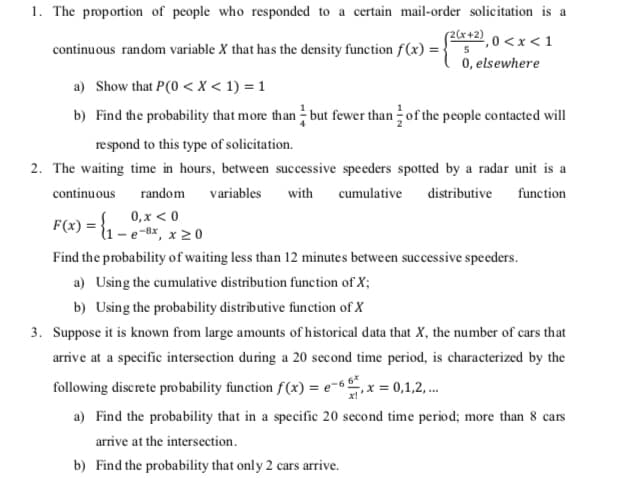1. The proportion of people who responded to a certain mail-order solicitation is a (2(x+2) 2,0
1. The proportion of people who responded to a certain mail-order solicitation is a (2(x+2) 2,0
Chapter7: Matrices And Determinants
Section7.2: Operations With Matrices
Problem 12ECP
Related questions
Question
100%

Transcribed Image Text:1. The proportion of people who responded to a certain mail-order solicitation is a
(2(x+2) , 0 <x < 1
0, elsewhere
continuous random variable X that has the density function f(x) =
a) Show that P(0 < x < 1) = 1
b) Find the probability that more than - but fewer than of the people contacted will
respond to this type of solicitation.
2. The waiting time in hours, between successive speeders spotted by a radar unit is a
continuous
random
variables
with
cumulative distributive function
0, x < 0
F(x) = {1 – e-Bx, x 2 0
Find the probability of waiting less than 12 minutes between successive speeders.
a) Using the cumulative distribution function of X;
b) Using the probability distrībutive function of X
3. Suppose it is known from large amounts of historical data that X, the number of cars that
arrive at a specific intersection during a 20 second time period, is characterized by the
following discrete pro bability function f(x) = e-x = 0,1,2,.
a) Find the probability that in a specific 20 second time period; more than 8 cars
arrive at the intersection.
b) Find the probability that only 2 cars arrive.
Expert Solution
This question has been solved!
Explore an expertly crafted, step-by-step solution for a thorough understanding of key concepts.
Step by step
Solved in 3 steps with 2 images

Recommended textbooks for you


Linear Algebra: A Modern Introduction
Algebra
ISBN:
9781285463247
Author:
David Poole
Publisher:
Cengage Learning


Linear Algebra: A Modern Introduction
Algebra
ISBN:
9781285463247
Author:
David Poole
Publisher:
Cengage Learning